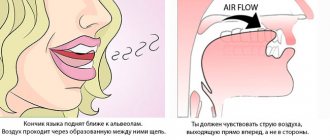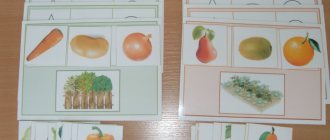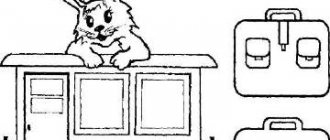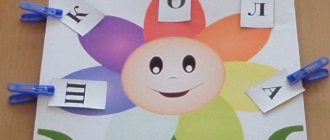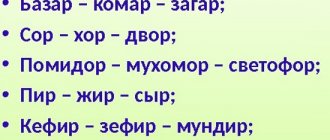Didactic material “Speech therapy games and labyrinths for sound automation”
Anna Kuzina
Didactic material “Speech therapy games and labyrinths for sound automation”
Sound automation is the development of a new skill that requires long-term systematic training. Since deficiencies in sound pronunciation are sometimes not an independent defect, but part of another, more complex, speech disorder, when automating sounds they simultaneously work on clarifying and expanding the vocabulary, on the syllabic structure of the word
Various games , exercises, and tasks to automate sounds The proposed material contributes to faster automation of sounds in spontaneous speech ; development of phonemic hearing, improvement of the syllabic structure of a word , correction of the lexico-grammatical structure of speech, consolidation of knowledge about automated sounds and corresponding letters, formation of the skill of sound-letter analysis of syllables and words . At the same time, fine motor skills of the fingers develop; activation of memory, attention, thinking. All this, in turn, is a timely prevention of dysgraphia (impaired written speech)
and dyslexia
(reading impairment)
.
Depending on the complexity of the child’s speech defect and the stage of correctional work, games and tasks can be used in combination.
The presented material turns the monotonous and monotonous work of reinforcing the pronunciation of sounds into an interesting game .
Games , tasks and exercises for automating sounds
Game " Labyrinth "
Material : labyrinth , pictures.
Progress of the game : children, clearly pronouncing the sound , name and attach pictures in a given order along the maze . The movement begins from the start. If the word begins incorrectly, then the next move cannot be made until the word is named correctly.
Game " Maze with pronunciation "
Material : labyrinth , pictures.
Progress of the game : children, when moving through the maze , not only name the pictures, but also indicate the direction of the next move. For example, the cap is to the right, the shaft is down.
Game " Reverse Labyrinth "
Material : small volumetric or flat toy (Appendix3)
with studied
sounds , pictures, labyrinth .
Progress of the game : first, children pronounce all the words - the names of the pictures laid out on the maze . Then he places the toy on the last picture of the maze and moves in the opposite direction, calling out the words.
Game "Color Maze "
Material : labyrinth , pictures.
Progress of the game : children name the pictures. Determine vowel (red)
or a consonant
, hard (blue)
or soft
(green)
.
Attach pictures only to red (blue, green)
on the playing field, explaining your choice.
Game "What's missing?"
Material : labyrinth , pictures.
Progress of the game : children are asked to remember the pictures on the maze . An adult closes or hides one picture using a magic screen, and the children guess. Attention is paid to the correct pronunciation of sounds .
Game "Magic Wand"
Material : labyrinth , pictures.
Game progress : touching with a “magic wand”
Before each picture on
the maze , children are asked to count them to five according to the pattern. Sample: tire - one tire, two tires, three tires, four tires, five tires.
Game “Where is the sound ?”
Materials : picture cards, playing field, tokens.
Progress of the game : the adult tells the children that in different words the sound can be at the beginning, in the middle, and at the end of the word. Shows pictures. Then he shuffles the cards and asks each child in turn to name the pictures and determine the location of the sound .
Children take turns each selecting one card and showing what they have. If the child selected correctly, correctly, he is given a token. Then the children select cards where the sounds are at the end of words, etc.
After each child has learned to locate the sound , the adult mixes the cards, gives the children an equal number of different cards and asks them to divide them into three parts. From left to right, where - put all the cards with a sound at the beginning of the word on one side, on the second side - in the middle of the word, on the third - at the end of the word.
For the correct answer, everyone is awarded a token. At the end of the game , children count their tokens. The player who collects the most tokens wins.
Game "One-Many"
Material : pictures, tokens, playing field.
Progress of the game : an adult shows a card and says, for example, one suitcase, many suitcases. Points to the picture of a suitcase on the playing field, attaches the picture and says - two suitcases. Children take turns repeating after the adult. For the correct answer and correct pronunciation of sounds, a token is awarded .
Game "Sleuths"
Materials : tokens, cards.
Progress of the game : an adult tells the players who the detectives are and invites them to play the most attentive detective . To do this, choose using a counting rhyme (children repeat the counting rhyme)
.
Then 3 or more cards are laid out in front of him. He must carefully for 20-30 seconds and remember them.
Then he closes his eyes, and the other players hide or change, or add 1 card. The one who collects the most tokens wins. An adult should pay attention to pronunciation and that players complete tasks correctly.
Game "Choose Your Team"
Material : tokens, pictures.
Progress of the game : the adult shows pictures (birds, animals, etc.)
. Then, at the teacher’s command, within a certain time, the players must collect, for example, only cards with birds or animals. Can be divided into teams. For correct answers, players are awarded tokens.
Game "Magic Path"
Material : playing field, cube, cards.
Progress of the game : an adult gives the players chips and explains the rules of the game : “Who will walk along the path faster? Throw the dice, move forward as many moves as the number on the dice, calling out the pictures.”
Game “Come up with phrases, sentences, phrases, stories”
Material : cards with syllables, pictures, tokens.
Progress of the game : an adult shows a picture, or a syllable with a certain sound . Asks you to come up with a phrase, sentence, phrase or story. For a correctly completed task, the child receives a token.
Game "Who is the smartest"
Material : riddles, pictures, tokens.
Progress of the game : an adult asks a riddle, then whoever found the picture first and named it correctly receives a token.
"Readers' Competition"
Material : poems, pictures.
Game progress : find a picture and recite a poem.
"Tongue twister competition"
Material : tokens with corresponding syllables, tongue twisters, tongue twisters.
Progress of the game : an adult uses a counting rhyme to determine the order of players (children repeat out loud)
.
After which the players repeat a pure tongue twister, a tongue twister with a certain sound , or different sounds .
The one who copes gets a token. After the children begin to memorize tongue twisters, you can play “Who knows the most tongue twisters?”
.
"Tell me a story"
Material : tokens, pictures.
Game progress : an adult hands each player 2 or more pictures. And he offers to compose a story, a story based on the pictures. Each child receives a token for completing the task correctly.
Such games and tasks can be carried out using a teaching aid sewn from fabric with Velcro “ Speech therapy labyrinth ”
.
Method of making the manual. Sew a square out of fabric, sew on a ribbon in the form of a labyrinth . Sew Velcro of different colors on top of the tape. Cut out pictures, chips, flat toys. to the pictures to secure the sounds on the back side. Use the same games and tasks .
"Sound Labyrinth". Methodological manual for children of preschool and primary school age
Yulia Afanasyeva
"Sound Labyrinth". Methodological manual for children of preschool and primary school age
Relevance
Speech is a great gift of nature, thanks to which people receive ample opportunities to communicate with each other. Speech unites people in their activities, helps to understand, shapes views and beliefs. Speech provides a person with a huge service in understanding the world.
However, nature gives a person very little time for the emergence and development of speech - early and preschool age . It is during this period that favorable conditions are created for the development of oral speech, the foundation is laid for written forms of speech (reading and writing)
and subsequent speech and language development of the child.
Currently, many children do not master the pronunciation of all sounds of their native language school .
There are many different games and exercises that help the speech therapist and teacher make the process of working with sounds more interesting for the child. I would like to bring to your attention an original development that I use in my pronunciation correction work.
Along with automation, this manual also covers other tasks for correcting speech pathology. I hope that this manual will help young speech therapists make classes with children more interesting and exciting for the child.
Description of the manual and annotation for use: on a card - folder (punched card)
pictures are depicted, and under each picture there is a cut out window
(square)
.
The punched card consists of 2 sheets. The top layer has pictures and windows - slits for painting. The bottom layer is a transparent sheet. Both layers are connected to each other in a “pocket”
.
A sheet of paper is placed in the folder. The pictures are selected in such a way that some of them contain a given sound in different positions : at the beginning, middle or end of the word. sound in their names , and paint over the holes under these pictures. After this, the sheet is removed from the folder, all notes are connected by lines. If the pictures are identified correctly, you should get a letter indicating the given sound .
When naming a picture, a child determines by ear the presence or absence of a given sound in a word , highlighting the automated sound . Then it can “transform”
a large object into a small one using a diminutive suffix: boots - boots. After playing one game, the child chooses another game.
Thus, he automates the delivered sound , practices agreement, formation of words or learns to compose sentences, trains in dividing words into syllables, and develops phonemic processes.
A set of games and exercises.
This methodological manual is compiled on the basis of didactic principles, taking into account the age characteristics of children 5-8 years old with speech disorders. The manual consists of 20 punched cards (all consonants of the Russian language)
.
The lexical material for games and exercises is selected taking into account many parameters necessary for the formation of practical skills and abilities in using corrected speech:
• Words with automated sounds (there are no pictures with oppositional sounds );
• Picture words that are accessible to children, so that children can recognize and name a familiar object in the picture;
• Words that have different numbers of syllables to determine their number;
• Words with different positions of sound in the word (beginning, middle, end)
• Masculine, feminine, neuter singular and plural words so children can practice inflecting words and hear that words have different endings.
Thus, with the help of this manual , used in subgroup and individual lessons, you can solve several problems at once: automate, differentiate sounds and at the same time practice the correct change and formation of words, agreement of words in phrases and sentences. This manual has prospects for further replenishment of the didactic base.
This manual was developed and painting material was selected during the summer period. Since the beginning of the school year 2015 - 2021, I have used it in working with children of senior preschool and primary school age (1st grade)
.
Children they can change, supplement or interchange the rules of the game at their own discretion, which is one of the main tasks of the Federal State Educational Standard. At the end of the lesson, children like to receive a finished product of their activity, which is meaningful and interesting not only to them, but also to the teacher. The child plays, builds his own rules, and the teacher, through the game, achieves his goal.

